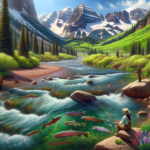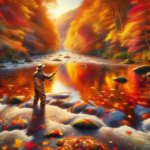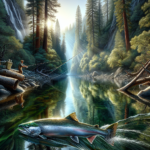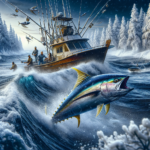Spring Panfish Fishing in Minnesota’s Lakes
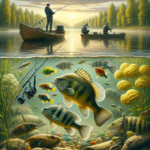
Introduction
Did you know that Minnesota is home to over 10,000 lakes, making it a paradise for anglers? Among these, spring panfish fishing stands out as a favorite pastime for both locals and visitors. This article will delve into the intricacies of spring panfish fishing in Minnesota’s lakes, covering everything from the best techniques and gear to the top fishing spots and seasonal considerations.
Whether you’re a seasoned angler or a beginner looking to dip your toes into the world of fishing, understanding the nuances of spring panfish fishing can significantly enhance your experience. This guide aims to provide you with all the information you need to make the most of your fishing trips in Minnesota.
Background/Context
Historical or Cultural Significance
Fishing has been an integral part of Minnesota’s culture for centuries. Native American tribes, such as the Ojibwe and Dakota, relied on the state’s abundant water bodies for sustenance. Over time, fishing evolved from a means of survival to a popular recreational activity. Today, Minnesota’s fishing culture is celebrated through various events, tournaments, and community gatherings.
Geographical Overview
Minnesota, often referred to as the “Land of 10,000 Lakes,” boasts a diverse range of water bodies, from small ponds to vast lakes. The state’s climate features cold winters and warm summers, creating ideal conditions for a variety of fish species. The local ecosystem includes lush forests, wetlands, and prairies, providing a rich habitat for panfish such as bluegill, crappie, and perch.
Key Points/Details
Fishing Techniques
Technique Overview
Spring panfish fishing in Minnesota typically involves techniques such as jigging, bobber fishing, and fly fishing. Jigging involves using a weighted lure to mimic the movement of prey, while bobber fishing uses a float to keep the bait at a specific depth. Fly fishing, though less common for panfish, can be effective in certain conditions.
When and Where to Use
Jigging is particularly effective in deeper waters where panfish tend to congregate during the early spring. Bobber fishing works well in shallow areas, especially near weed beds and submerged structures. Fly fishing can be used in clear, shallow waters where panfish are actively feeding on insects.
Recommended Gear
- Rods: Light to ultralight rods are ideal for panfish due to their sensitivity and flexibility.
- Reels: Spinning reels are commonly used for their ease of use and versatility.
- Lines: Monofilament lines with a 2-6 lb test are suitable for panfish.
- Bait/Lures: Live bait such as worms and minnows, as well as artificial lures like jigs and soft plastics, are effective.
Species Information
Species Overview
The primary panfish species targeted in Minnesota include bluegill, crappie, and perch. Bluegill are known for their aggressive feeding habits and can be found in shallow waters during the spring. Crappie, both black and white, prefer slightly deeper waters and are often found near submerged structures. Perch are versatile and can be caught in various depths and conditions.
Best Practices
To successfully catch panfish, it’s essential to match your bait and techniques to the species’ behavior. For bluegill, small jigs tipped with worms or insects work well. Crappie can be caught using minnows or small soft plastic lures. Perch are often attracted to small jigs and live bait such as minnows or worms.
Location Information
Top Fishing Spots
- Lake Minnetonka: Known for its abundant panfish population, especially crappie and bluegill.
- Leech Lake: Offers excellent fishing opportunities for perch and bluegill.
- Lake Mille Lacs: A popular spot for crappie and perch, with numerous access points and amenities.
- Lake Vermilion: Known for its diverse fish population, including bluegill and crappie.
Regulations and Licenses
Anglers in Minnesota must adhere to state fishing regulations, which include obtaining a fishing license. Specific regulations, such as catch limits and seasonal restrictions, vary by lake and species. It’s essential to check the Minnesota Department of Natural Resources (DNR) website for up-to-date information before heading out.
Seasonal Considerations
Seasonal Variations
Spring is an ideal time for panfish fishing as the warming waters trigger spawning behavior, making fish more active and easier to catch. As the season progresses, panfish move from deeper waters to shallower areas to spawn. Understanding these patterns can help anglers adjust their techniques and locations accordingly.
Best Times to Fish
The optimal time for spring panfish fishing is during the pre-spawn and spawn periods, typically from late April to early June. Early morning and late afternoon are the best times of day, as panfish are most active during these cooler periods.
Events and Tournaments
Event Overview
Minnesota hosts several fishing events and tournaments throughout the spring, catering to anglers of all skill levels. Notable events include the Governor’s Fishing Opener and various local panfish tournaments.
Preparation Tips
To prepare for a fishing event or tournament, ensure your gear is in top condition, practice your techniques, and familiarize yourself with the event’s rules and regulations. Pre-fishing the tournament waters can also give you a competitive edge.
Tips and Best Practices
General Tips
- Use light tackle to increase sensitivity and improve your chances of detecting bites.
- Pay attention to water temperature and adjust your fishing depth accordingly.
- Experiment with different baits and lures to find what works best on a given day.
Avoid Common Mistakes
- Avoid using heavy tackle, as it can spook panfish and reduce your chances of success.
- Don’t overlook shallow areas, especially during the spawn period when panfish move closer to shore.
- Ensure you have the correct fishing license and are aware of local regulations to avoid fines.
Advanced Techniques
- Try using a slip bobber rig to easily adjust your fishing depth without retying your line.
- Use a fish finder to locate schools of panfish in deeper waters.
- Experiment with different jigging techniques, such as vertical jigging or casting and retrieving, to find what works best.
Gear and Equipment Recommendations
Essential Gear
- Light to ultralight fishing rod
- Spinning reel
- Monofilament fishing line (2-6 lb test)
- Assorted jigs, soft plastics, and live bait
- Bobbers and slip bobbers
Optional Gear/Upgrades
- Fish finder
- Portable tackle box
- Polarized sunglasses to reduce glare and see fish more clearly
- Fishing net for easier landing of fish
Where to Buy or Rent
Local bait and tackle shops, such as Joe’s Sporting Goods in St. Paul and Thorne Bros in Blaine, offer a wide range of fishing gear. Online retailers like Bass Pro Shops and Cabela’s also provide extensive selections. For those looking to rent equipment, many local marinas and outdoor outfitters offer rental services.
Safety and Conservation
Safety Tips
- Always wear a life jacket when fishing from a boat.
- Check the weather forecast before heading out and be prepared for sudden changes.
- Inform someone of your fishing plans and expected return time.
- Carry a first aid kit and know basic first aid procedures.
Conservation Practices
- Practice catch and release to help maintain healthy fish populations.
- Follow local fishing regulations and respect catch limits.
- Avoid disturbing natural habitats and dispose of trash properly.
- Use barbless hooks to minimize injury to fish.
Planning Your Trip
Accommodations
Minnesota offers a variety of accommodations near popular fishing spots, ranging from campgrounds and cabins to hotels and resorts. Notable options include Grand View Lodge on Gull Lake and Chase on the Lake in Walker.
Travel Tips
Minnesota is accessible by car, with major highways connecting key fishing destinations. For those flying in, Minneapolis-Saint Paul International Airport is a convenient entry point. Renting a car is recommended for exploring the state’s numerous lakes and fishing spots.
Additional Activities
In addition to fishing, Minnesota offers a range of outdoor activities such as hiking, boating, and wildlife watching. The state is also home to several cultural attractions, including the Minnesota State Capitol and the Mall of America.
Frequently Asked Questions (FAQs)
What is the best time of year for panfish fishing in Minnesota?
The best time for panfish fishing is during the spring, from late April to early June, when fish are most active and spawning.
Do I need a fishing license to fish in Minnesota?
Yes, a fishing license is required for anglers aged 16 and older. Licenses can be purchased online or at local retailers.
What are the most common panfish species in Minnesota?
The most common panfish species include bluegill, crappie, and perch.
What gear do I need for panfish fishing?
Essential gear includes a light to ultralight fishing rod, spinning reel, monofilament line, assorted jigs, soft plastics, live bait, and bobbers.
Conclusion
Spring panfish fishing in Minnesota’s lakes offers a rewarding experience for anglers of all skill levels. By understanding the best techniques, gear, and locations, you can maximize your chances of success and enjoy the state’s rich fishing culture. Whether you’re targeting bluegill, crappie, or perch, this guide provides all the information you need to plan a successful fishing trip. So grab your gear, head to one of Minnesota’s beautiful lakes, and enjoy the thrill of spring panfish fishing!

